Announcements
Drinks
European utilities: hedged volumes, power prices support credit ratings, at least until 2025-26
By Sebastian Zank, Managing Director, Corporate Ratings
The favourable hedging impact will be most important for those utilities able to benefit from high market prices as their marginal costs of production have changed little, namely those with nuclear, hydroelectric and other renewables capacity, and to a lesser degree, lignite.
The short- to medium-term benefit for these so-called inframarginal producers comes despite more conservative hedging after the heavy margining deposits for exchange-based hedging which bit into the utilities’ cash positions when European energy prices spiked between H1 2022/H12023.
Still, our research shows that Europe’s largest utilities have hedged typically 50-90% of volumes for the next year, 20-60% for 2025 and up to 40% for 2026 (Figure 1).
Figure 1: Outright hedged generation volumes, leading European utilities
(latest reporting dates, %)
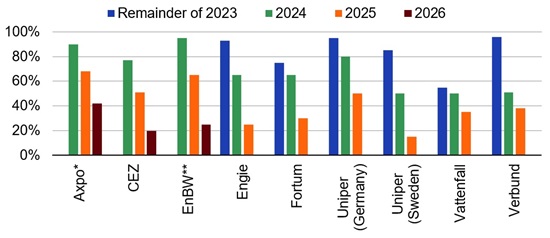
* Axpo has end-Sept financial year, so hedging ratios are shown for 2023/24, 2024/25 and 2025/26
** Midpoints of ranges provided by EnBW
Source: company reports/presentations, Scope
Utilities lock in favourable prices for 2024-25
Not all utilities publicly disclose hedge volumes and corresponding price levels, but the broad picture is clear: the utilities have locked in prices for a significant amount of the recurring electricity generation volumes for 2024, 2025 and in some cases 2026 within a range of EUR 45-150/MWh, significantly above the historical average which stands within a range of EUR 20-50/MWh (Figure 2). Rare exceptions are power generators such as Fortum Oyj or Uniper SE’s German unit.
Utilities like Austria’s Verbund AG, Switzerland’s Axpo Holding SA, Czechia’s CEZ as and France’s Engie SA have reported hedged prices which are well above historical averages. This will not automatically translate into higher margins and operating cash flows for a utility’s entire electricity generation fleet, but at least for those assets running off a low cost base.
The promise of elevated prices and increased operating earnings in electricity generation is well timed for the sector. Europe’s utilities face mounting capital expenditure largely earmarked for the ramp-up of new generation capacity – mostly renewables– and investment in upgrading grid infrastructure. Higher earnings in generation can to some extent cover the higher capex requirements and thereby limit the need for external funding. This clearly helps to keep leverage under control and retain headroom on credit ratings.
Figure 2: Hedged prices (EUR/MWh) locked in vs. past average achieved prices
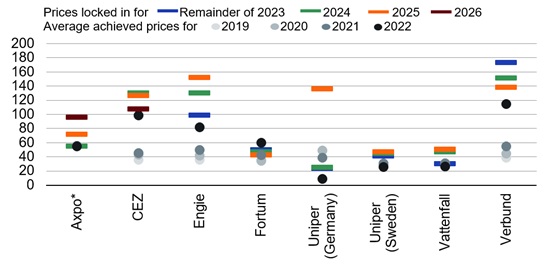
* Axpo has end-Sept financial year, so hedging ratios shown for 2023/24, 2024/25 and 2025/26
Source: company reports/presentations, Scope
Prices have peaked; downward pressure on cashflow, operating margins longer term
There is limited transparency about unhedged generation volumes. However, those utilities with large volumes of hedged electricity output at favourable prices and able to provide power at peak times – i.e., companies with flexible and/or reserve generation capacity – are most likely to record continuously higher operating earnings at their generating segments.
A look at the forward curves of baseload electricity prices in major European markets suggests that prices for the yet unhedged generation volumes are trending down but remain widely above the historical average (Figure 3).
Still, we flag that new hedges closed in the coming months and quarters will be a lower prices considering much of hedging closed for 2024 and 2025 was done as or right after electricity prices peaked between H2 2021 and H2 2022. Hence, it will be difficult repeat hedges at these record prices for the years beyond 2025.
In the medium to long term, utilities can expect structurally lower revenues and cashflow for their power generation assets for three reasons.
- Lower input prices for the power plants that set the marginal price within the merit order system will feed through to electricity prices.
- Shifts within the merit order will involve newer, lower-cost generation capacity pushing higher-cost capacity out of the system.
- Growing, though only gradual, integration of different power-price zones though better interconnectors across Europe will increase market efficiency and lower prices.
Figure 3: Baseload future prices for key European markets (EUR/MWh, 10/12/23)
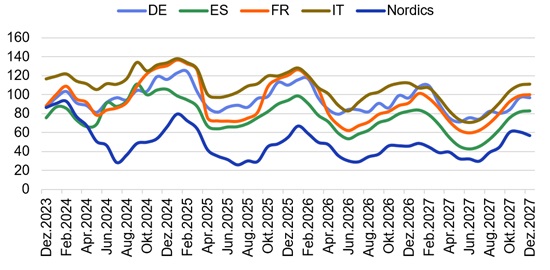
Source: Bloomberg, Scope
For consumers – industrial and commercial customers as well as private customers who get billed by energy retailers – any relief from high electricity bills will materialise only in the longer term. Industrial and commercial electricity consumers can reduce their energy bills to some extent through own production or bilateral procurement from low-cost energy generators through power purchase agreements, but retail customers will likely have to take the full hit.
Sector retains ample capex cover
The 33 utilities which have significant exposure to power generation in Scope’s coverage continue to have satisfactory capex coverage, as measured by operating cash flow over gross capex. The companies range from large pan-European companies such as Axpo Holding AG, CEZ as, Eléctricité de France SA, Enel SpA, Engie SA, Iberdrola SA, Statkraft SF, Uniper SE, and Vattenfall SE to smaller Scandinavian utilities such as Hafslund AS, Eviny AS, and Å Energi AS.
Most utilities will have ample room to cover capex, as they had in 2020 and 2021 (Figure 4). With operating cash flow covering gross capex by more than 100% on average (which already takes into account higher taxation), the utilities have additional headroom for discretionary spending. Nordic utilities are even set to increase their capex budgets for the next few years, bolstered by the extra cash earned from elevated energy prices since 2021.
Figure 4: Capex coverage of covered integrated utilities and pure power generators
(Operating cash flow/gross capex)
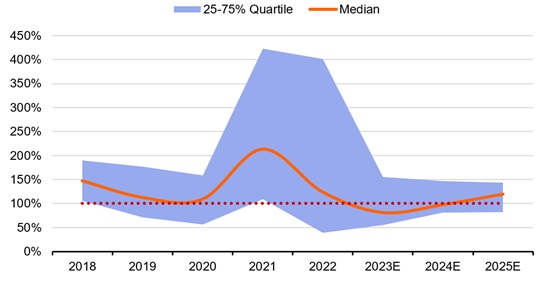
Source: Scope estimates
Still, this headroom will shrink when cashflow from power generation subsides in the medium to long term. Hence, capex programmes need to be synched with the cash accrued in the past three years and/or with the operating cash flow expected over the next few years.
Utilities with lower-cost generation capacity benefit the most
Not all utilities are benefitting from the supportive price environment. Higher prices cannot necessarily compensate for generation assets which are unfavourably positioned in the merit order, reduced earnings in other segments and/or significantly increased capex. This means that generators with high-cost generation capacity at the end of the merit order system, such as hard coal and gas, will continue to earn thin to no extra margin, unless they can earn a solid margin through the provision of reserve capacity.
Still, many European utilities with significant exposure to electricity generation such as Switzerland’s Axpo, Norwegian utilities with large hydro capacity – such as Statkraft, Hafslund, Å Energi, Haugaland Kraft AS and Eviny – and smaller Hungarian firms such as Alteo Energiaszolgáltató Nyrt and Greenergy Holding Zrt are beneficiaries of rising cash inflows and cash accruals, thereby improving credit metrics such as leverage and cash flow cover.
For others, they are at least benefiting from sufficient cashflow gains to maintain or restore credit metrics to create a cushion for their credit ratings, an important achievement at times of (re)financing at higher base rates.
As a result, the financial risk profiles of utilities we cover have improved over the past three years with only few exceptions (Figure 5). The median assessment of utilities covered for at least three years improved by one notch on average, with some rare improvements of up to five notches for utilities which started at a low base.
Figure 5: Transition of financial risk profile assessments in notches: 2023 vs one to three years before (European integrated utilities and pure power generators in Scope’s coverage*)
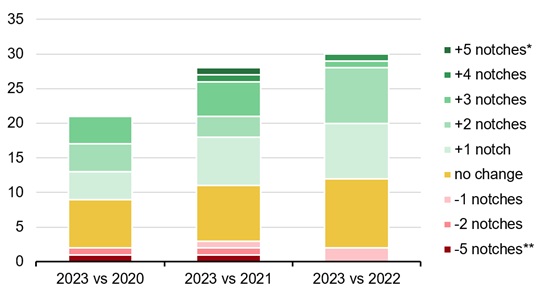
Number of rating assessments increases YoY reflecting Scope’s continued ramp-up of its utilities coverage
* Very strong improvement related to Hungarian utility Greenergy; ** Very strong deterioration related to Germany’s Uniper in 2022
Source: Scope
Such favourable developments naturally drove rating actions over the past few years which – as shown in Figure 6 – have been dominated by favourable actions such as positive Outlook revisions and upgrades.
Judging by the significant number of Positive rating Outlooks we expect more executions of rating upgrades. In the current price environment, we see reduced risk of major downgrades over the next 12 to 18 months and rather a solidification of ratings unless operating cashflows come in significantly lower than projected and/or capex programmes are increased significantly beyond the utilities’ most recent announcements.
Figure 6: Ratings drift for integrated utilities, pure power generators (2022-23)
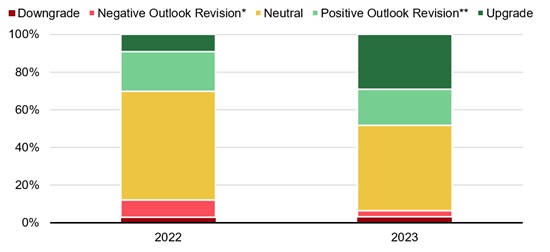
* Includes reversions of Positive Outlooks to Stable/Negative; Outlook revisions from Stable to Negative; Under review placements for a possible downgrade
* Includes reversions of Negative Outlooks to Stable/Positive; Outlook revisions from Stable to Positive; Under review placements for a possible upgrade
Source: Scope
For more on Scope’s recent power price research, please check out the following reports:
European utilities: capex-heavy pursuit of decarbonisation tests credit quality; funding still ample, Dec 2023
European utilities: continued electricity price hedging promises producer gain, consumer pain, Apr 2023
Access all Scope rating & research reports on ScopeOne, Scope’s digital marketplace, which includes API solutions for Scope’s credit rating feed, providing institutional clients access to Scope’s growing number of corporate, bank, sovereign and public sector ratings.







